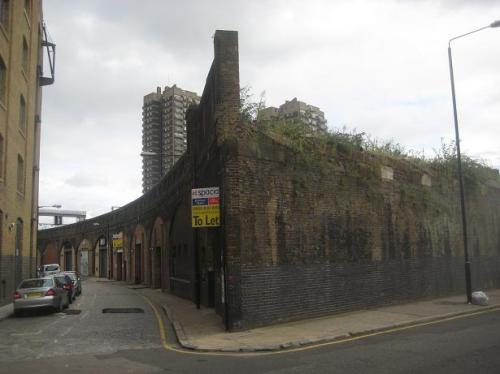I mentioned in my last post that I’m a great enthusiast for the joys of research. So, when planning my new layout set in the East End, what better way to research it than to actually get out there?
I started out in Shadwell, taking the Docklands Light Railway. I’m a big fan of the DLR, because it’s simultaneously very modern and very historic. It utilises a lot of the old infrastructure of lines long since closed. For instance, here it runs on the viaducts of the old London and Blackwall Railway. These were very characteristic of railways in West London, where gravelly soil made tunnelling difficult.

- I thought this was the old station building. Wikipedia begs to differ.
Further East, the railway has been built on new concrete flyovers. At West India Dock, there’s a veritable spaghetti junction of lines passing over and under each other as the trains try to figure out which way they’re going. From here, it’s a short walk back to Tower Gateway, following the route of the line.

The picture above was taken just short of Tower Gateway, and shows both the original London and Blackwall Railway viaduct and the later Midland Railway goods station building – this line was used by the London, Tilbury and Southend Railway and the North London Railway, both of which ran into the L&BR’s Fenchurch Street terminus. The goods station had a roof back in the 1980s, and now forms part of a car park. Car parks have little respect for history.

"You know, I don't believe this train goes to Poplar at all."
Above is pictured another historic feature of interest. One of the selling points used by the builders of the L&BR, or the Commercial Railway as it was known in those early days, was that by putting the railway on a viaduct, the arches could be converted into houses or shops – a nice little moneyspinner, and one in the eye for the rival scheme supported by George and Robert Stephenson for a railway built in a cutting. One slightly unexpected by-product of this was that when the lines were closed, they couldn’t demolish the viaducts, being as how they were occupied. So as a result, you’ll get long stretches of overgrown, trackless viaduct which suddenly end at the road.

You probably can't read that street sign.
This photo shows the area the line runs into – Fenchurch Street on the main line and Tower Gateway on the DLR. The reason I’ve taken a photo of this particular bridge is because it’s a significant place for modellers. This street is, in fact, the original Minories.
Minories, in model railway terms, is a layout plan by the late, great Cyril Freezer for a compact city terminus station. See http://carendt.com/scrapbook/page85b/index.html for a tribute to Cyril and a reproduction of Minories (along with some of his other well-known plans). The layout doesn’t look much like the real Minories – it was actually inspired by Liverpool Street. But as Cyril was an East London boy, he would almost certainly have been familiar with the area.
The real Minories was doomed from the start. As I said above, the L&BR was originally known as the Commercial Railway, for the simple reason that it didn’t actually enter the City of London itself. They had to settle for Minories, a short distance from the Tower of London, which opened from 1840. It was only the following year that an extension was completed to Fenchurch Street. It wasn’t a long extension, but it did give the Commercial Railway that all-important presence in the City – the only line at the time to have a station in what was then considered Central London. Minories was immediately demoted to the poor relation. It was too close to Fenchurch Street to prosper, and in 1853 it was closed entirely and converted into a goods yard for the newer terminus.

Minories Station. The L&BR was originally cable-hauled, hence the lack of locomotives in this picture.
That, by the way, is what became the Midland Railway goods station shown above.
Minories wasn’t gone for good, though. With the decline of goods traffic on British Railways (thanks again, Beeching), the goods station was abandoned. Fast forward to the 1980s, and the Docklands Light Railway was looking for a site for its western terminus. Well, here was a ready-made terminus site, just a couple of minutes’ walk from BR’s Fenchurch Street and London Underground’s Tower Hill. So it was that Minories had the last laugh – under the new name of Tower Gateway.
Further Reading
http://www.telegraph.co.uk/news/obituaries/technology-obituaries/5517020/Cyril-Freezer.html – Telegraph obituary for Cyril Freezer, briefly touching on Minories and his East End childhood.
http://www.themodelrailwayclub.org/docs/minories.htm – A literal version of Minories, using an imaginary extension of the Great Northern Railway.
